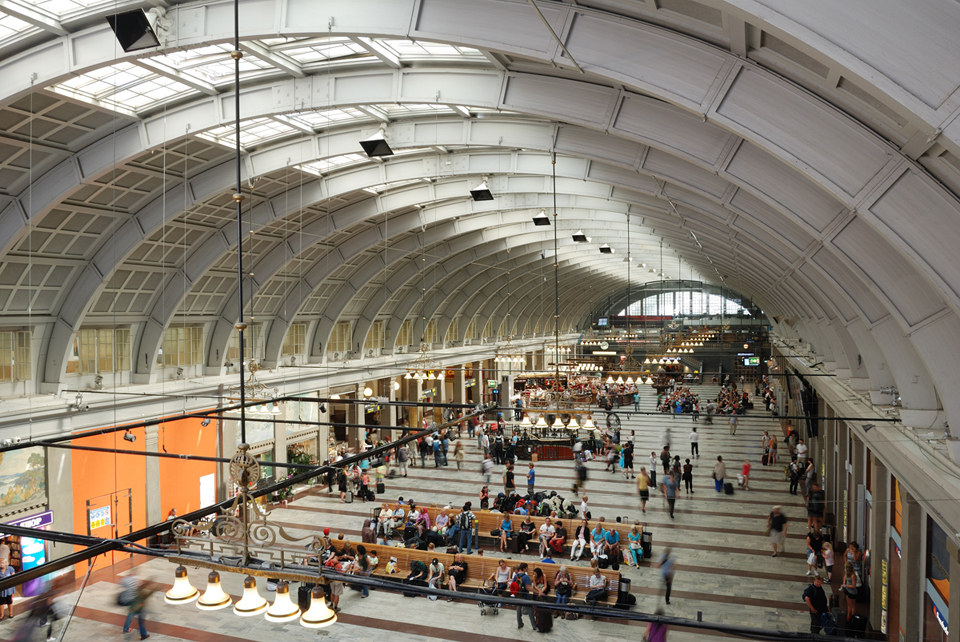A few weeks ago I was in Umea, Sweden, attending and speaking at the 2014 Design Research Society biennial conference. This was a fascinating experience in many ways, and may inspire future posts, but it is my experience in the Stockholm train station that inspires this one.
Originally finished in the 1870s, the station’s design has been updated through an environmentally-conscious strategy, and now harvests the body heat of its 200,000 daily users to help heat another close-by complex. This station has stood the test of time, and has had ingenious updates making it extremely efficient and future conscious. The design of the station could also be called “cool”, integrating new technologies with 140-year old building materials. Its beautiful and expansive arched ceiling dominates its bright and functional interior.
 Figure 1: Stockholm central station
Figure 1: Stockholm central station
Image courtesy of Ankara / Wikimedia Commons
The station is full of shops, one of which sells “cool” designer products and gifts. In my eyes, these are consumer items, where the role of design is to make them appear clever and look trendy, driving buyers to buy, discard later, and buy again. You have seen these items before; colourful plastic kitchen items, novelty gifts, and small disposable household gadgets. So I am standing in a 140-year old train station, helping to heat a nearby building, looking at plastic, disposable, designer consumer products.
Is design just window dressing? Should we even be associated with cheap disposable products? So this gets me thinking about superficiality and design, and I think back to the way I used to look at visual design when I began my career.
Over 25 years ago working in Toronto, my young work friends and I had some cool “lingo” we used to describe various attributes of visual design. I still remember that we used to label a design with immediate stylistic appeal with the term “skoodily-wa” (adjective). This led to intelligent comments such as “that’s pure skoodily-wa”, or occasionally a simple and straightforward “skoodily-wa-wa-wa”. To us, skoodily-wa meant that the design had a powerful design aesthetic – that it appealed to us with its overt designerly approach. Skoodily-wa meant it was cool, and probably just cool to designers, which we all were. Thus, it celebrated our culture. It also meant it was “in”, and that you could be with the “in crowd” by being part of it through association. To us, it was a visual “high five”. A win for the (design) team.
Can you guess where we unearthed the term, skoodily-wa, or are you so culturally literate that you already know?
The Flintstones.
In the 1960 Flintstones cartoon episode (season 1, episode 2) Hot Lips Hannigan, Fred and Barney mistakenly think they’ve made their wives disappear (using Fred’s magicians kit), and decide to have a night on the town before making them reappear. They head off to a nightclub where they run into one of Fred’s high school buddies, the jazz trumpet playing bandleader, Hot Lips Hannigan. Fred quickly assumes the role of the band’s lead singer, assuming the improvised nickname The Golden Smog.
Their wives, Wilma and Betty (who only pretended to disappear), dress up as teenagers and follow them to the nightclub, catching them in the act of showing off to the wild teenage music fans. Hot Lips Hannigan, the band’s leader, attempts to run interference between Fred and Barney, and their wives, with his cool superficial lingo, opening the conversation with a super-cool “skoodily-wa-wa-wa, contact”. Wilma, Fred’s wife, is not impressed with this his superficial muttering and calls his bluff, delivering a heavy thump to Hot Lips’ head.
So in a 1960s Flintstones episode, skoodily-wa represented all that was superficial and meaningless, but 30 years later, we appropriated it to represent what we thought was cool. The “in” thing.
Reflecting on the term’s original meaning, I question the role that skoodily-wa plays in design today. Does skoodily-wa drive consumerism? Do we consciously integrate a degree of transitoriness into designed objects and ensure that they are discarded later? Is it easier for designers to make things appear new and better, rather than actually making them better? Is good design “cool”, or is design that is just “cool” design, created in a world concerned with sustainability, design that is basically flawed? If design is to be meaningful it should rise above hollow consumer product appeal. In these cases design becomes the engine of consumption. Shouldn’t, good, conscientious, sustainable design fight against superficial consumerism and needless consumption? Maybe this depends on your definition of design.
After reflecting on the Stockholm train station, and the designer items within, I feel designers depend on skoodily-wa too often. Designers need to face this fact. How about championing quality, effect and innovation over just style. Instead of skoodily-wa , maybe we should be striving for a little more “skadoosh”.



How did you manage to work in “Skadoosh” and not “Greatgoogleymoogley” ?